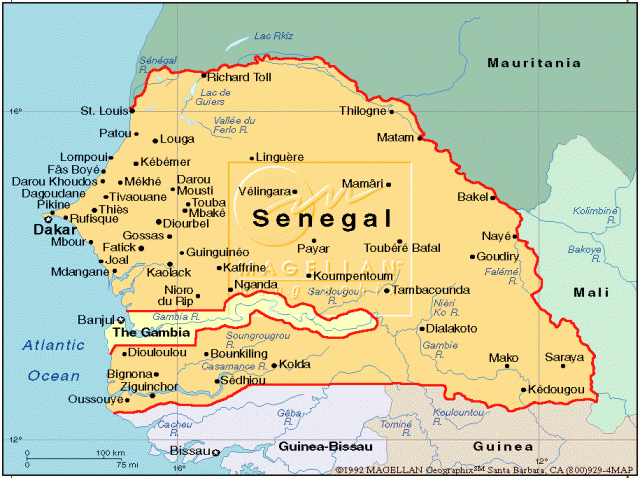Senegal
Area 75,749 square mi (196,190 square km)
Population 14.67 million (2014)
Capital Dakar
Highest Point 581 ft (177 m)
Lowest Point 0 m
GDP $15.66 billion (2014)
Primary Natural Resources fish, phosphates, iron ore, natural gas.
SENEGAL IS A FLAT, low-lying arid country located on the westernmost cape of Africa. Bounded by the ATLANTIC OCEAN, MAURITANIA, MALI, GUINEA, and GUINEABISSAU, Senegal has well-defined dry and rainy seasons. The wet season lasts from June to October, with occasional tornadoes usually followed by thunder, lightning, and wind squalls. Annual rainfall ranges from 13 in (34 cm) in the extreme north to 61 in (155 cm) in the southwest. During the dry season, usually from December to February, southwesterly winds called harmattan, bring in dry and dusty air from the SAHARA DESERT; temperatures are cool at night and scorchingly hot during the day.

Senegal is mostly covered with rolling plains and is usually divided into five regions: the coastal region, the Senegal River Valley, the Ferlo in the north, the Eastern Region, and the Cassamance. The northern region is covered by savannah woodlands where elephant grass is the most characteristic vegetation, interspersed by mahogany, rosewood, and baobab, and fruit cultivation such as mango, guava, orange, tangerine, grapefruit, coconut, papaya and tamarind. The Cassamance, which is separated from the rest of the country by the Gambia River, is markedly different from other areas. It receives abundant rainfall, which supports rice growing, luxuriant forest, and oil palm plantation.
There are a network of seven national parks that support the conservation of more than 300 species of birds, 70 species of animals, and at least 60 species of fish. The Niokolo-Koba National Park is a major tourist attraction that allows tourists to watch a sample of African wildlife such as buffalo, gazelles, black antelope, bushbuck, roan antelope, waterbuck, hippopotamuses, lions, apes, crocodiles, and warthogs.
Most of the Senegalese population reside in coastal urban areas, with over 2.5 millions living in Dakar the primate capital city, and Saint-Louis, the third-largest city and second-largest port. Dakar, the westernmost city of Africa is 75 ft (23m) above sea level. The city enjoys a salubrious temperate local climate with moderate temperatures and an annual rainfall of 23 in (58 cm).
As a capital city, it is the center of administration, cosmopolitan culture, trade, and industry. About 75 percent of the country's trade passes through the city, which is the main hub of all modes of transportation and the premier tourist destination in the country. The only university in the country, Universite de Cheik Anta Diop, is located in the northwest suburb of Dakar. Approximately 95 percent of Senegal's population are black Africans, mostly Muslim representing over a dozen ethnic groups, each with its own customs and language. The three largest groups are Wolof (36 percent), Fulani (17 percent), and Serer (17 percent). The French language and way of life are encouraged to minimize ethnic differences.
Politically, Senegal is a republic that is dominated by one ruling party (the Socialist Party) since independence in 1960. In 2000, however, through a coalition with other opposition parties, the Senegalese Democratic Party was able to defeat the Socialist Party and install their leader Abdoulaye Wade as president. The economy is based on agriculture, which for over a century was dependent on groundnut as a cash crop. Diversification into poultry production, cotton, and ricegrowing has been successful compared to the dismal performance of the subsistence sector, where the cultivation of crops as corn, millet, and sorghum either stagnated or declined, making it necessary for Senegal to import more than a third of its food requirements. Fishing for both local consumption and export is a major source of revenue; in 2000 the revenue from fish exports was $239 million compared to $79 million from groundnuts. Other exports include phosphate, iron ore, gold and titanium. Tourism is a growing industry that contributes 10 percent of national income.
Although as a destination Senegal has much to offer in terms of natural attraction (beaches, climate, wildlife, landscapes), history, and culture, tourists' experience is likely to be affected by increasing encounters with petty crimes and street hustlers. As with many other developing countries, Senegal is unfortunately burdened with foreign debt. In 2001, it owed international bodies such as the World Bank, International Monetary Fund, and commercial banks around $3.5 billion, which is nearly the value of its gross domestic product.